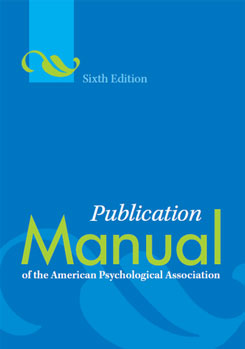Quick Guide to APA Citation (6th ed.) | In-Text Citation & Reference List
APA style is one of the most common formats for citing sources Other well known citation styles include MLA and Chicago.
APA Style citations consist of two parts:
- In-text citation: A brief citation in parentheses when you mention a source, citing the author’s last name and the year of publication, e.g. (Smith, 2019). It identifies the full source in the reference list.
- Reference list entry: Full publication details listed on the reference page, which appears at the end of your paper. The reference provides all the information needed to find the source, e.g. Smith, P. (2019, April 18). Citing Sources in APA Format. Retrieved April 21, 2019, from https://www.scribbr.com/apa-style/
This citation guide is based on the 6th edition of the APA Manual. The latest edition, published in October 2019, is not yet supported, but we have compiled a quick guide to the most important 7th edition changes.
Table of contents
In-text citations
An in-text citation is a concise way to show the reader where the original idea came from and to give credit to the original author. Use one every time you quote or paraphrase a source.
Include the author’s last name and the year of publication. When quoting a source, it’s also necessary to include the page number(s) of the quote.
- An earlier study in which X and Y were compared revealed that … (Smith, 2017).
- Smith (2017) shows how, in the past, research into X was mainly concerned with …
2 authors
When there are two authors, separate their last names with an ampersand (&), or with the word ‘and’ when they appear in the running text.
- Research shows that there is a great need for … (Reynolds & Thomas, 2014).
- Reynolds and Thomas (2014) write that there is a great need for …
3-5 authors
When there are three or more authors, separate their last names using commas. The last two authors’ last names should be separated by both a comma and an ampersand.
- Recent research suggests that there is … (McGuire, Morrison, Reynolds, & Thomas, 2014).
- McGuire, Morrison, Reynolds, and Thomas (2014) argue that …
If you cite the same source again, to save space, you shorten the citation. Instead of including all the authors’ names, include only the first author, followed by “et al.” (meaning “and others”).
- In this research, many participants made use of … (McGuire et al., 2014).
- McGuire et al. (2014) noticed that …
6 or more authors
If a source has six or more authors, use the shortened version from the first citation.
- Lunott et al. (2015) discuss the …
Organization as author
When a source does not list an individual author, it can often be attributed to an organization instead.
- According to new research … (Microsoft, 2014).
Quotes
When you quote a source, you also have to add the page number to the in-text citation.
- According to the company’s business plan, “making an APA Citation Generator is a lot of work, but many students benefit from it” (Swan, 2014, p. 5).
Multiple sources in one citation
Sometimes, it’s necessary to cite multiple sources in one sentence. You can combine them into one set of parentheses, separated by semicolons.
- Various studies show that … (Docker & Vagrant, 2002; Porter, 1997; Lima, Swan, & Corrieri, 2012).
Reference list
Every source cited in the text must also appear in your reference list.
The format differs depending on the source type, but every reference begins in the same way: with the author’s last name and initials, the publication year or date, and the title of the source.
Book citations
Note: Book titles should be italicized.
- Format
Last Name, Initials. (Year). Book title (edition). City, State/Country: Publisher. - Example
Porter, M. E. (1998). Competitive strategy: Techniques for analyzing industries and competitors (3rd ed.). New York, NY: Free Press.
Journal article citations
Note: The journal title and volume number should be italicized.
- Format
Last Name, Initials., & Last Name, Initials. (Year). Article title. Journal Name, Volume(Issue), Page Number(s). https://doi.org/DoiNumber - Example
Andreff, W., & Staudohar, P. D. (2000). The evolving European model of professional sports finance. Journal of Sports Economics, 1(3), 257–276. https://doi.org./10.1177/152700250000100304
Website citations
- Format
Last Name, Initials. (Year, Month Day). Page title [OptionalType]. Retrieved from http://webaddress - Example
Worland, J. (2015, July 27). U.S. flood risk could be worse than we thought. Retrieved from http://time.com/3973256/flooding-risk-coastal-cities
Report citations
Note: The title should be italicized.
- Format
Organization Name or Author Last Name, Initials. (Year). Report title. Retrieved from http://webaddress - Example
Royal Bank of Scotland. (2015). Annual report and accounts 2014. Retrieved from http://investors.rbs.com/~/media/Files/R/RBS-IR/2014-reports/annual-report-2014.pdf
More APA Style examples
Do you want to cite an image, interview, YouTube video, movie, or another source type that is not on this list? We have many more APA Style examples to help you cite correctly.
Sorting the reference list
Sort the references in alphabetical order based on the author’s last name. If you cite multiple sources by the same author, then sort them by publication year.
When you use the APA Citation Generator, your reference list is alphabetized automatically.
APA formatting for papers
There are certain formatting rules you must adhere to when writing a paper in APA format.
The basic requirements are:
- Times New Roman 12 pt
- Double line spacing
- One-inch (2.54 cm) margins
- Left-aligned running head with a shortened title and page number
In addition to these general rules, there are more specific requirements for formatting the title page, running head, abstract, reference page, and headings and subheadings.

